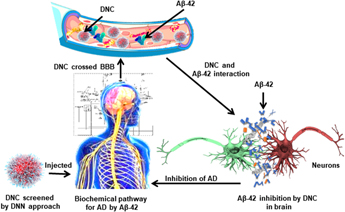Focus Issue: (Nano)materials for Biomedical Applications
(Nano)materials for Biomedical Applications
Introduction
-
- Published online by Cambridge University Press:
- 14 June 2019, p. 1827
-
- Article
- Export citation
REVIEW
Synthesis, surface modification, and applications of magnetic iron oxide nanoparticles
-
- Published online by Cambridge University Press:
- 30 April 2019, pp. 1828-1844
-
- Article
- Export citation
Article
Evaluation and validation of synergistic effects of amyloid-beta inhibitor–gold nanoparticles complex on Alzheimer’s disease using deep neural network approach
-
- Published online by Cambridge University Press:
- 21 January 2019, pp. 1845-1853
-
- Article
- Export citation
G-protein-coupled receptors function as logic gates for nanoparticle binding using systems and synthetic biology approach
-
- Published online by Cambridge University Press:
- 20 February 2019, pp. 1854-1867
-
- Article
- Export citation
Electrochemical single-step obtention and characterization of a biomimetic TiO2-HA NTs covered by chitosan
-
- Published online by Cambridge University Press:
- 13 March 2019, pp. 1868-1878
-
- Article
- Export citation
Development of multilayered biomimetic bone plates: In vitro release assessment
-
- Published online by Cambridge University Press:
- 21 January 2019, pp. 1879-1891
-
- Article
- Export citation
Nanostructured surface coatings for titanium alloy implants
-
- Published online by Cambridge University Press:
- 04 March 2019, pp. 1892-1899
-
- Article
- Export citation
The mineralization of polymer electrospun fibrous membranes modified with tourmaline nanoparticles
-
- Published online by Cambridge University Press:
- 04 March 2019, pp. 1900-1910
-
- Article
- Export citation
Antimicrobial hydrogels with controllable mechanical properties for biomedical application
-
- Published online by Cambridge University Press:
- 07 May 2019, pp. 1911-1921
-
- Article
- Export citation
Study of a luminescent and antibacterial biomaterial based on hydroxyapatite as support for an antineoplastic drug
-
- Published online by Cambridge University Press:
- 07 May 2019, pp. 1922-1930
-
- Article
- Export citation
Formation of aligned core/sheath microfiber scaffolds with a poly-L-lactic acid (PLLA) sheath and a conductive poly(3,4-ethylenedioxythiophene) (PEDOT) core
-
- Published online by Cambridge University Press:
- 04 June 2019, pp. 1931-1943
-
- Article
- Export citation
Assessing the influence of silkworm cocoon’s age on the physicochemical properties of silk fibroin-based materials
-
- Published online by Cambridge University Press:
- 03 May 2019, pp. 1944-1949
-
- Article
- Export citation
REVIEW
Exploration of interactions of ‘blood-nano interface’ of carbon-based nanomaterials for biomedical applications
-
- Published online by Cambridge University Press:
- 31 May 2019, pp. 1950-1964
-
- Article
- Export citation
Front Cover (OFC, IFC) and matter
JMR volume 34 issue 11 Cover and Front matter
-
- Published online by Cambridge University Press:
- 14 June 2019, pp. f1-f5
-
- Article
-
- You have access
- Export citation
Back Cover (OBC, IBC) and matter
JMR volume 34 issue 11 Cover and Back matter
-
- Published online by Cambridge University Press:
- 14 June 2019, pp. b1-b4
-
- Article
-
- You have access
- Export citation













